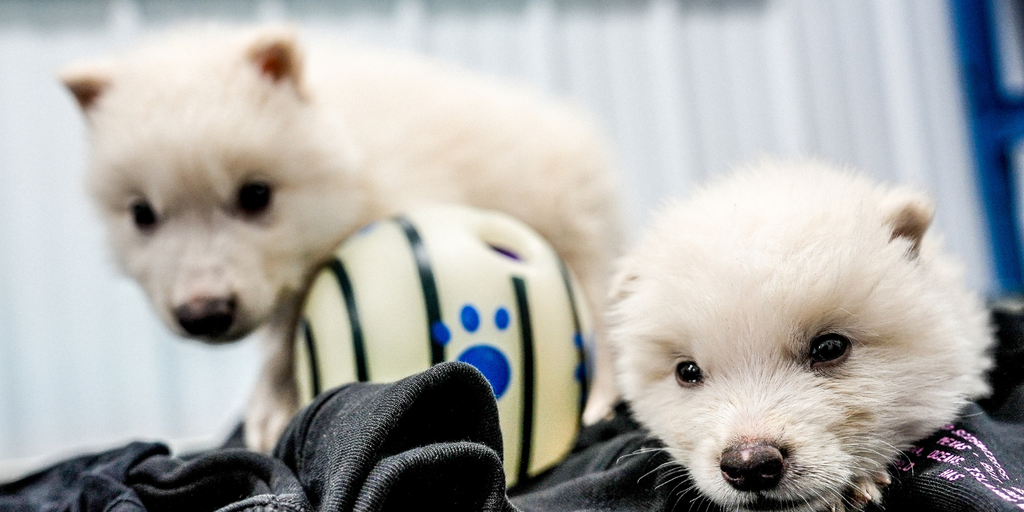
Colossal Biosciences, a Texas-based genetic engineering company, claimed this week it had “de-extincted” the dire wolf—thrilling scientists and Game of Thrones fans alike. While Colossal said the dire wolves were revived using ancient DNA, how close are they to the real thing?
The company makes it clear that they’re not “cloning” in the traditional sense, instead, they’re using genetic engineering and synthetic biology in a process often referred to as “de-extinction” or “genetic rescue.” Colossal said it completed the de-extinction of the dire wolf using DNA extracted from a 13,000-year-old tooth and a 72,000-year-old inner ear bone. Combined with advanced gene editing and cloning technologies, the company produced three puppies named Remus, Romulus, and Khaleesi—an homage to both Roman mythology and Game of Thrones.
“We de-extincted core genes from ancient DNA—just like Jurassic Park,” Colossal Biosciences founder and CEO Ben Lamm told Decrypt. “We found those genes and engineered them onto a wolf cell line. They’re not hybrids. We didn’t breed them together. We engineered them—just like Jurassic Park.”
SOUND ON. You’re hearing the first howl of a dire wolf in over 10,000 years. Meet Romulus and Remus—the world’s first de-extinct animals, born on October 1, 2024.
The dire wolf has been extinct for over 10,000 years. These two wolves were brought back from extinction using… pic.twitter.com/wY4rdOVFRH
— Colossal Biosciences® (@colossal) April 7, 2025
Like Moo Deng before it, the excitement around the dire wolves even led to the launch of a dire wolf-themed Solana meme coin on Pump.fun.
Lamm said Colossal partnered with conservationists and Indigenous groups to bring the project to life, noting that this collaboration was part of the decision to focus on species native to North America.
“We’re running a buffalo restoration project to better understand population genetics and species diversity in the buffalo population,” he said.
Despite the excitement on social media, Lamm clarified what went into making the dire wolves possible.
“You can’t clone an extinct animal—there are no living cells,” Lamm said. “All you can work with are fossils and fragments of bone to extract ancient, highly fragmented DNA.”
Dire wolves went extinct roughly 13,000 years ago, near the end of the last Ice Age. Their disappearance likely resulted from losing their primary food sources and increased competition from other predators, such as gray wolves.
“If you believe that Jurassic Park is a movie about genetically modified organisms with DNA from frogs, birds, crocodiles, and ancient DNA from dinosaurs, then you would say that ours is a genetically modified wolf with ancient alleles from dire wolves,” Lamm said.
Lamm said the question of whether these animals are truly dire wolves is more philosophical than scientific.
“Everything in life is an admixture—that’s how speciation works. Even our two dire wolves weren’t 100% dire wolves,” he said. “The concept of purity belongs to eugenics, not science.”
When asked whether his company is “playing God,” Lamm said humans already are.
“We play God every day,” he said. “We’re on track to lose up to 50% of all biodiversity by 2050.”
Lamm said that in addition to reviving extinct species, Colossal Bioscience is also working to support conservation efforts to combat biodiversity loss.
“All the technologies Colossal develops with conservation applications—we give them away for free,” he said. “We also set up the Colossal Foundation and raised $50 million to support even more conservation work.”
Lamm said bold action is required to fight extinction events and that de-extinction isn’t about preparing for the future.
“The reason we’re doing this is simple—we need new tools and a deeper understanding of the full process,” he said. “With extinction accelerating, it’s better to have de-extinction capabilities and not need them than to need them and not have them.”
Edited by Josh Quittner
Generally Intelligent Newsletter
A weekly AI journey narrated by Gen, a generative AI model.
#Bioscience #Firm #Combines #Ancient #DNA #Science #Bring #Dire #Wolf























